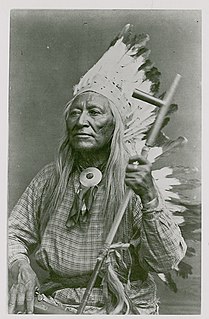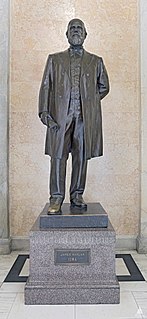The Shoshone or Shoshoni are a Native American tribe with four large cultural/linguistic divisions:

Washakie was a prominent leader of the Shoshone people during the mid-19th century. He was first mentioned in 1840 in the written record of the American fur trapper, Osborne Russell. In 1851, at the urging of trapper Jim Bridger, Washakie led a band of Shoshones to the council meetings of the Treaty of Fort Laramie (1851). Essentially from that time until his death, he was considered the head of the Eastern Shoshones by the representatives of the United States government. In 1979, he was inducted into the Hall of Great Westerners of the National Cowboy & Western Heritage Museum.

The Wind River Indian Reservation, in the west-central portion of the U.S. state of Wyoming, is shared by two Native American tribes, the Eastern Shoshone and the Northern Arapaho. Roughly 60 mi (97 km) east to west by 50 mi (80 km) north to south, the Indian reservation is located in the Wind River Basin, and includes portions of the Wind River Range, Owl Creek Mountains, and Absaroka Range.

Fort Washakie was a U.S. Army fort in what is now the U.S. state of Wyoming. The fort was established in 1869 and named Camp Augur after General Christopher C. Augur, commander of the Department of the Platte. In 1870 the camp was renamed Camp Brown in honor of Captain Frederick H. Brown, who was killed in the Fetterman Massacre in 1866.

Sacagawea was a Lemhi Shoshone woman who, at age 16, helped the Lewis and Clark Expedition in achieving their chartered mission objectives by exploring the Louisiana Territory. Sacagawea traveled with the expedition thousands of miles from North Dakota to the Pacific Ocean, helping to establish cultural contacts with Native American populations and contributing to the expedition's knowledge of natural history in different regions.

James Trosper is an Arapahoe running the Eastern Shoshone Sun Dance chief and “a respected voice on traditional Plains Indian spirituality.” He is Director of the High Plains American Indian Research Institute. HPAIRI facilitates a wide variety of partnerships between the University of Wyoming and the tribes of the Wind River Indian Reservation in Fort Washakie, Wyoming “to work together in ways that empower tribes, nurture innovation for American Indian sustainability, and demonstrate respect for Native peoples’ cultures, traditions, laws, and diverse expressions of sovereignty.”

Benjamin Matthew Victor is an American sculptor living and working in Boise, Idaho. He is the only living artist to have three works in the National Statuary Hall in the United States Capitol. He was only 26 years old when his first statue, Sarah Winnemucca, a Paiute activist in Nevada, was dedicated in the Hall in 2005, making him the youngest artist to ever be represented in the Hall. In 2014, his sculpture of Norman Borlaug, "the father of the Green Revolution," was dedicated in the National Statuary Hall and in 2019, his statue of Chief Standing Bear, a Native American rights leader, was dedicated in the National Statuary Hall making him the only living artist to have three sculptures in the Hall.

George Washington is a large bronze sculpture of George Washington by John Quincy Adams Ward, installed on the front steps of Federal Hall National Memorial on Wall Street in New York City.

John McLoughlin, also known as Dr. John McLoughlin, is a bronze sculpture of John McLoughlin by Alexander Phimister Proctor and completed by his son Gifford MacGregor Proctor. One statue is installed at the Oregon State Capitol grounds in Salem, Oregon; another is installed in Washington, D.C., as part of the National Statuary Hall Collection.

Edmund Kirby Smith is a bronze sculpture commemorating the United States Army officer of the same name by C. Adrian Pillars, installed in the United States Capitol Visitor Center as part of the National Statuary Hall Collection. The statue was gifted by the state of Florida in 1922.

Sakakawea is a monumental sized bronze sculpture created by Leonard Crunelle. It was dedicated on October 13, 1914 and stands on the grounds of the North Dakota State Capitol in Bismarck, North Dakota.
Barry Goldwater is a bronze sculpture depicting American politician and businessman of the same name by Deborah Copenhaver Fellows, installed at the United States Capitol's National Statuary Hall, in Washington, D.C., as part of the National Statuary Hall Collection. The statue was donated by the U.S. state of Arizona in 2015, and replaced a statue of John Campbell Greenway, which the state of Arizona gifted to the collection in 1930.

Helen Keller is a bronze sculpture depicting the American author and political activist of the same name by Edward Hlavka, installed in the United States Capitol Visitor Center's Emancipation Hall, in Washington, D.C., as part of the National Statuary Hall Collection. The statue was gifted by the U.S. state of Alabama in 2009, and replaced one depicting Jabez Lamar Monroe Curry, which had been donated in 1908.

Philip Kearny is an 1888 bronze sculpture of Philip Kearny by Henry Kirke Brown, installed in the United States Capitol, in Washington, D.C., as part of the National Statuary Hall Collection. It is one of two statues donated by the state of New Jersey.

Esther Hobart Morris is a bronze sculpture depicting the first woman justice of the peace in the United States by Avard Fairbanks.

Ephraim McDowell is a bronze sculpture depicting the American physician and surgeon of the same name by Charles Henry Niehaus, installed in the United States Capitol Visitor Center, in Washington, D.C., as part of the National Statuary Hall Collection. The statue was gifted by the U.S. state of Kentucky in 1929.
Junípero Serra, or Father Junipero Serra, is a bronze sculpture depicting the Roman Catholic Spanish priest and friar Junípero Serra by Ettore Cadorin.
James Shields is an 1893 bronze sculpture of James Shields by Leonard Volk, installed in the United States Capitol, in Washington, D.C., as part of the National Statuary Hall Collection. It is one of two statues donated by the state of Illinois. The sculpture was unveiled by Senator Shelby Moore Cullom of Illinois on December 6, 1893.

James Harlan is a bronze sculpture of American attorney and politician of the same name by Nellie Walker, formerly installed in Washington, D.C.'s United States Capitol, as part of the National Statuary Hall Collection. The statue, which was gifted by the U.S. state of Iowa in 1910, was replaced with one portraying Norman Borlaug in 2014.

In 2019, the U.S. state of Nebraska donated a bronze sculpture of Standing Bear by Benjamin Victor to the National Statuary Hall Collection. The statue is installed in the United States Capitol's National Statuary Hall, in Washington, D.C.

















